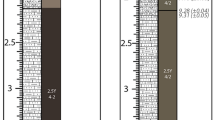Abstract
Aerial surveys and surface samples in the spring of 1985, showed that slicks of coral eggs and embryos (coral spawn) formed in large numbers within and between reefs in the Central Great Barrier Reef Region. Coral-spawn slicks appeared on the days immediately following the annual mass multispecific spawning of reef corals. They were white or pink in colour, and were often highly elongate in form extending up to 5 km in length, and 10 m in width. Over 99% of each slick sampled during the surveys consisted of dead eggs, embryos and their breakdown products, which formed dense, highly viscous patches readily recognizable during aerial surveys. Despite the low proportion of live material, the slicks contained high concentrations of live embryos (15 to 230 per litre) which were over two orders of magnitude greater than concentrations in adjacent water masses. The distinctive colour, shape and texture of the coral-spawn slicks generally distinguished them from slicks formed by blooms of the blue-green alga Oscillatoria erythraea, which also occur commonly in the region. Many of the slicks were closely associated with surface oceanographic features, such as fronts between water parcels, and wakes and eddies behind reefs. Although more detailed sampling and surveys are required, these results suggest that it may be possible to track the movements of coral embryos and larvae directly for the first one or two days following mass spawning, and indirectly thereafter by monitoring other surface features.
Similar content being viewed by others
Literature cited
Alldredge, A. L. and W. M. Hamner: Recurring aggregation of zooplankton by a tidal current. Estuar. cstl mar Sci. 10, 31–37 (1980)
Babcock, R. C., G. D. Bull, P. L. Harrison, A. J. Heyward, J. K. Oliver, C. C. Wallace and B. L. Willis: Synchronous spawnings of 105 scleractinian coral species on the Great Barrier Reef. Mar. Biol. 90, 379–394 (1986)
Bull, G. D.: Planktonic dispersal of larval corals, 13 pp. (1984). (Unpublished Report to Great Barrier Reef Marine Park Authority. Townsville, Australia)
Bull, G. D.: Distribution and abundance of coral plankton: Coral Reefs 4, 197–200 (1986)
Butler, J. N.: Pink stripe on the ocean. Nat. Hist. N.Y., 89, 62–63 (1980)
Doherty, P. J.: Tropical territorial damselfishes: is density limited by aggression or recruitment? Ecology 64, 176–190 (1983)
Ewing, G. C.: Relation between band slicks at the surface and internal waves in the sea. Science, N.Y. 111, 91–94 (1950)
Hamner, W. M. and J. W. Carleton: Copepod swarms: attributes and roles in coral reef ecosystems. Limnol. Oceanogr. 24, 1–14 (1974)
Hamner, W. M. and I. R. Hauri: Fine scale surface currents in the Whitsunday Islands, Queensland, Australia: effect of tide and topography. Aust. J. mar. Freshwat. Res. 28, 333–359 (1977)
Harrison, P. L., R. C. Babcock, G. D. Bull, J. K. Oliver, C. C. Wallace and B. L. Willis: Mass spawning in tropical reef corals. Science, N.Y. 223, 1186–1189 (1984)
Hodgson, G.: Abundance and distribution of planktonic coral larvae in Kaneohe Bay, Oahu, Hawaii. Mar. Ecol. Prog. Ser. 26, 61–67 (1985)
Kingsford, M. J. and J. H. Choat: Influence of surface slicks on the distribution and onshore movements of small fish. Mar. Biol. 91, 161–171 (1986)
Leis, J. M.: Vertical and horizontal distribution of fish larvae near coral reefs at Lizard Island, Great Barrier Reef. Mar. Biol. 90, 505–516 (1986)
Marsh, H.: Results of the aerial survey for dugongs conducted in the Cape Bedford to Cape Melville area in November 1984, 67 pp. (1985). (Unpublished Report to the Great Barrier Reef Marine Park Authority, Townsville, Australia)
Norton-Griffiths, M.: Counting animals, 139 pp. Nairobi: African Wildlife Leadership Foundation, 1978. (Handbook No. 1, Serengeti Ecological Monitoring Programme)
Shanks, A. L.: Surface slicks associated with tidally forced internal waves may transport pelagic larvae of benthic invertebrates and fishes shoreward. Mar. Ecol. Prog. Ser. 13, 311–315 (1983)
Wallace, C. C.: Seasonal peaks and annual fluctuations in recruitment of juvenile scleractinian corals. Mar. Ecol. Prog. Ser. 21, 289–298 (1985)
Williams, D. McB.: Daily, monthly and yearly variation in recruitment of a guild of coral reef fishes. Mar. Ecol. Prog. Ser. 10, 231–237 (1983)
Williams, D. McB. and P. F. Sale: Spatial and temporal patterns of recruitment of juvenile coral reef fishes to coral habitats within “One Tree Lagoon”, Great Barrier Reef. Mar. Biol. 65, 245–253 (1981)
Williams, D. McB., E. Wolanski and J. C. Andrews: Transport mechanisms and the potential movement of planktonic larvae in the central region of the Great Barrier Reef. Coral Reefs 3, 229–236 (1984)
Willis, B. L., R. C. Babcock, P. L. Harrison, J. K. Oliver and C. C. Wallace: Patterns in the mass spawning of corals on the Great Barrier Reef from 1981 to 1984. Proc. 5th int. coral Reefs Congr. 4, 343–348 (1985). (Ed. by C. Gabrie et al. Moorea, French Polynesia: Antenne Mueum-EPHE)
Wolanski, E., J. Imberger and M. L. Heron: Island wakes in shallow coastal waters. J. geophys. Res. 89, 10 553–10 569 (1984)
Wolanski, E. and D. L. B. Jupp: Studying the water circulation around coral reefs using LANDSAT, planes, ships and current meters. LANDSAT'84, Proc. 3rd Australas. Conf. remote Sensing, 174–183 (1984). (Ed. by E. W. Walker, Brisbane, Australia: Organizing Committee)
Zeldis, J. R. and J. B. Jillett: Aggregations of pelagic Munida gregaria (Fabricus) (Decapoda, Anomura) by coastal fronts and internal waves. J. Plankton Res. 4, 839–857 (1982)
Author information
Authors and Affiliations
Additional information
Communicated by G. F. Humphrey, Sydney
Rights and permissions
About this article
Cite this article
Oliver, J.K., Willis, B.L. Coral-spawn slicks in the Great Barrier Reef: preliminary observations. Mar. Biol. 94, 521–529 (1987). https://doi.org/10.1007/BF00431398
Accepted:
Issue Date:
DOI: https://doi.org/10.1007/BF00431398




